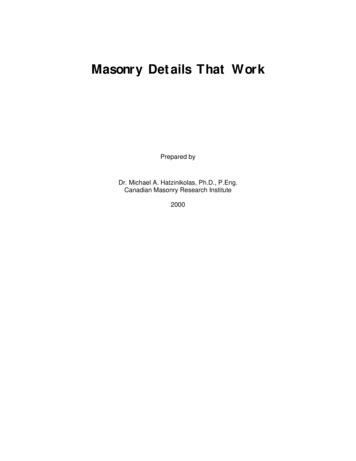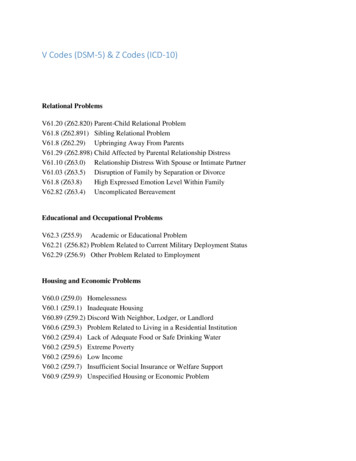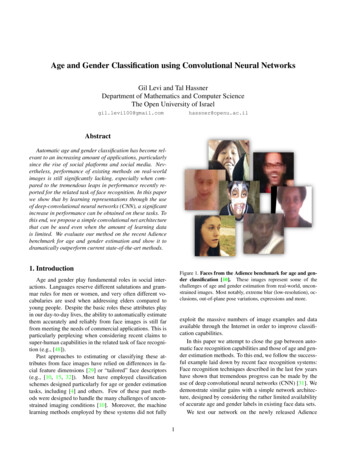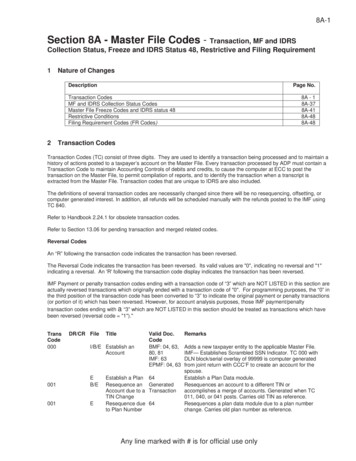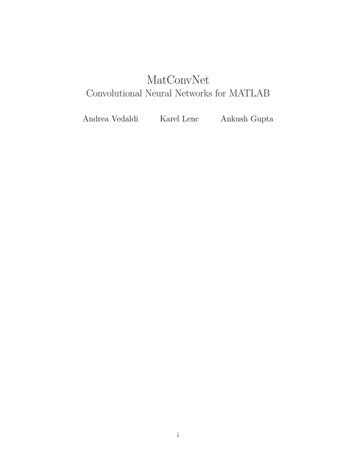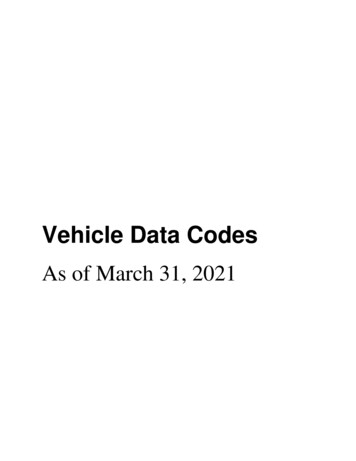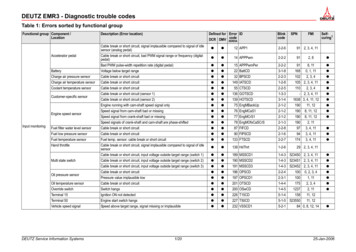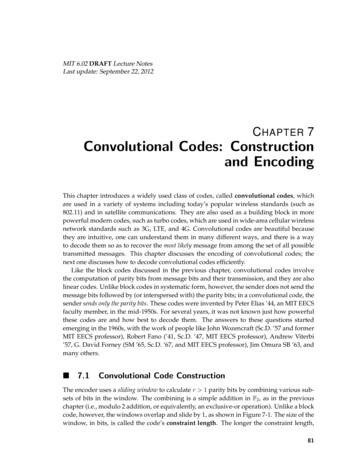
Transcription
MIT 6.02 DRAFT Lecture NotesLast update: September 22, 2012C HAPTER 7Convolutional Codes: Constructionand EncodingThis chapter introduces a widely used class of codes, called convolutional codes, whichare used in a variety of systems including today’s popular wireless standards (such as802.11) and in satellite communications. They are also used as a building block in morepowerful modern codes, such as turbo codes, which are used in wide-area cellular wirelessnetwork standards such as 3G, LTE, and 4G. Convolutional codes are beautiful becausethey are intuitive, one can understand them in many different ways, and there is a wayto decode them so as to recover the most likely message from among the set of all possibletransmitted messages. This chapter discusses the encoding of convolutional codes; thenext one discusses how to decode convolutional codes efficiently.Like the block codes discussed in the previous chapter, convolutional codes involvethe computation of parity bits from message bits and their transmission, and they are alsolinear codes. Unlike block codes in systematic form, however, the sender does not send themessage bits followed by (or interspersed with) the parity bits; in a convolutional code, thesender sends only the parity bits. These codes were invented by Peter Elias ’44, an MIT EECSfaculty member, in the mid-1950s. For several years, it was not known just how powerfulthese codes are and how best to decode them. The answers to these questions startedemerging in the 1960s, with the work of people like John Wozencraft (Sc.D. ’57 and formerMIT EECS professor), Robert Fano (’41, Sc.D. ’47, MIT EECS professor), Andrew Viterbi’57, G. David Forney (SM ’65, Sc.D. ’67, and MIT EECS professor), Jim Omura SB ’63, andmany others. 7.1Convolutional Code ConstructionThe encoder uses a sliding window to calculate r 1 parity bits by combining various sub sets of bits in the window. The combining is a simple addition in F2 , as in the previouschapter (i.e., modulo 2 addition, or equivalently, an exclusive-or operation). Unlike a blockcode, however, the windows overlap and slide by 1, as shown in Figure 7-1. The size of thewindow, in bits, is called the code’s constraint length. The longer the constraint length,81
82CHAPTER 7. CONVOLUTIONAL CODES: CONSTRUCTION AND ENCODINGFigure 7-1: An example of a convolutional code with two parity bits per message bit and a constraint length(shown in the rectangular window) of three. I.e., r 2, K 3.the larger the number of parity bits that are influenced by any given message bit. Becausethe parity bits are the only bits sent over the channel, a larger constraint length generallyimplies a greater resilience to bit errors. The trade-off, though, is that it will take consider ably longer to decode codes of long constraint length (we will see in the next chapter thatthe complexity of decoding is exponential in the constraint length), so one cannot increasethe constraint length arbitrarily and expect fast decoding.If a convolutional code produces r parity bits per window and slides the window for ward by one bit at a time, its rate (when calculated over long messages) is 1/r. The greaterthe value of r, the higher the resilience of bit errors, but the trade-off is that a propor tionally higher amount of communication bandwidth is devoted to coding overhead. Inpractice, we would like to pick r and the constraint length to be as small as possible whileproviding a low enough resulting probability of a bit error.In 6.02, we will use K (upper case) to refer to the constraint length, a somewhat un fortunate choice because we have used k (lower case) in previous chapters to refer to thenumber of message bits that get encoded to produce coded bits. Although “L” might bea better way to refer to the constraint length, we’ll use K because many papers and doc uments in the field use K (in fact, many papers use k in lower case, which is especiallyconfusing). Because we will rarely refer to a “block” of size k while talking about convo lutional codes, we hope that this notation won’t cause confusion.Armed with this notation, we can describe the encoding process succinctly. The encoderlooks at K bits at a time and produces r parity bits according to carefully chosen functionsthat operate over various subsets of the K bits.1 One example is shown in Figure 7-1,which shows a scheme with K 3 and r 2 (the rate of this code, 1/r 1/2). The encoderspits out r bits, which are sent sequentially, slides the window by 1 to the right, and thenrepeats the process. That’s essentially it.At the transmitter, the two princial remaining details that we must describe are:1. What are good parity functions and how can we represent them conveniently?2. How can we implement the encoder efficiently?The rest of this chapter will discuss these issues, and also explain why these codes arecalled “convolutional”.1By convention, we will assume that each message has K - 1 “0” bits padded in front, so that the initialconditions work out properly.
83SECTION 7.2. PARITY EQUATIONS 7.2Parity EquationsThe example in Figure 7-1 shows one example of a set of parity equations, which governthe way in which parity bits are produced from the sequence of message bits, X. In thisexample, the equations are as follows (all additions are in F2 )):p0 [n] x[n] x[n - 1] x[n - 2]p1 [n] x[n] x[n - 1](7.1)The rate of this code is 1/2.An example of parity equations for a rate 1/3 code isp0 [n] x[n] x[n - 1] x[n - 2]p1 [n] x[n] x[n - 1]p2 [n] x[n] x[n - 2](7.2)In general, one can view each parity equation as being produced by combining the mes sage bits, X, and a generator polynomial, g. In the first example above, the generator poly nomial coefficients are (1, 1, 1) and (1, 1, 0), while in the second, they are (1, 1, 1), (1, 1, 0),and (1, 0, 1).We denote by gi the K-element generator polynomial for parity bit pi . We can thenwrite pi [n] as follows:k-1Xpi [n] (gi [j]x[n - j]).(7.3)j 0The form of the above equation is a convolution of g and x (modulo 2)—hence the term“convolutional code”. The number of generator polynomials is equal to the number ofgenerated parity bits, r, in each sliding window. The rate of the code is 1/r if the encoderslides the window one bit at a time. 7.2.1An ExampleLet’s consider the two generator polynomials of Equations 7.1 (Figure 7-1). Here, the gen erator polynomials areg0 1, 1, 1g1 1, 1, 0(7.4)If the message sequence, X [1, 0, 1, 1, . . .] (as usual, x[n] 0 8n 0), then the parity
84CHAPTER 7. CONVOLUTIONAL CODES: CONSTRUCTION AND ENCODINGbits from Equations 7.1 work out to bep0 [0] (1 0 0) 1p1 [0] (1 0) 1p0 [1] (0 1 0) 1p1 [1] (0 1) 1p0 [2] (1 0 1) 0p1 [2] (1 0) 1p0 [3] (1 1 0) 0(7.5)p1 [3] (1 1) 0.Therefore, the bits transmitted over the channel are [1, 1, 1, 1, 0, 0, 0, 0, . . .].There are several generator polynomials, but understanding how to construct goodones is outside the scope of 6.02. Some examples, found originally by J. Bussgang,2 areshown in Table 7-1.Constraint 11011110011001Table 7-1: Examples of generator polynomials for rate 1/2 convolutional codes with different constraintlengths. 7.3Two Views of the Convolutional EncoderWe now describe two views of the convolutional encoder, which we will find useful inbetter understanding convolutional codes and in implementing the encoding and decod ing procedures. The first view is in terms of shift registers, where one can construct themechanism using shift registers that are connected together. This view is useful in devel oping hardware encoders. The second is in terms of a state machine, which correspondsto a view of the encoder as a set of states with well-defined transitions between them. Thestate machine view will turn out to be extremely useful in figuring out how to decode a setof parity bits to reconstruct the original message bits.
SECTION 7.3. TWO VIEWS OF THE CONVOLUTIONAL ENCODER85Figure 7-2: Block diagram view of convolutional coding with shift registers. 7.3.1Shift-Register ViewFigure 7-2 shows the same encoder as Figure 7-1 and Equations (7.1) in the form of a blockdiagram made up of shift registers. The x[n - i] values (here there are two) are referred toas the state of the encoder. This block diagram takes message bits in one bit at a time, andspits out parity bits (two per input bit, in this case).Input message bits, x[n], arrive from the left. The block diagram calculates the paritybits using the incoming bits and the state of the encoder (the k - 1 previous bits; two in thisexample). After the r parity bits are produced, the state of the encoder shifts by 1, with x[n]taking the place of x[n - 1], x[n - 1] taking the place of x[n - 2], and so on, with x[n - K 1]being discarded. This block diagram is directly amenable to a hardware implementationusing shift registers. 7.3.2State-Machine ViewAnother useful view of convolutional codes is as a state machine, which is shown in Fig ure 7-3 for the same example that we have used throughout this chapter (Figure 7-1).An important point to note: the state machine for a convolutional code is identical forall codes with a given constraint length, K, and the number of states is always 2K-1 . Onlythe pi labels change depending on the number of generator polynomials and the valuesof their coefficients. Each state is labeled with x[n - 1]x[n - 2] . . . x[n - K 1]. Each arc islabeled with x[n]/p0 p1 . . . In this example, if the message is 101100, the transmitted bitsare 11 11 01 00 01 10.This state-machine view is an elegant way to explain what the transmitter does, and alsowhat the receiver ought to do to decode the message, as we now explain. The transmitterbegins in the initial state (labeled “STARTING STATE” in Figure 7-3) and processes themessage one bit at a time. For each message bit, it makes the state transition from thecurrent state to the new one depending on the value of the input bit, and sends the paritybits that are on the corresponding arc.The receiver, of course, does not have direct knowledge of the transmitter’s state transi 2Julian Bussgang, “Some Properties of Binary Convolutional Code Generators,” IEEE Transactions on In formation Theory, pp. 90–100, Jan. 1965. We will find in the next chapter that the (110, 111) code is actuallyinferior to another rate-1/2 K 3 code, (101, 111).
86CHAPTER 7. CONVOLUTIONAL CODES: CONSTRUCTION AND ENCODINGFigure 7-3: State-machine view of convolutional coding.tions. It only sees the received sequence of parity bits, with possible bit errors. Its task is todetermine the best possible sequence of transmitter states that could have produced theparity bit sequence. This task is the essence of the decoding process, which we introducenext, and study in more detail in the next chapter. 7.4The Decoding ProblemAs mentioned above, the receiver should determine the “best possible” sequence of trans mitter states. There are many ways of defining “best”, but one that is especially appealingis the most likely sequence of states (i.e., message bits) that must have been traversed (sent)by the transmitter. A decoder that is able to infer the most likely sequence the maximumlikelihood (ML) decoder for the convolutional code.In Section 6.2, we established that the ML decoder for “hard decoding”, in which thedistance between the received word and each valid codeword is the Hamming distance,may be found by computing the valid codeword with smallest Hamming distance, andreturning the message that would have generated that codeword. The same idea holdsfor convolutional codes. (Note that this property holds whether the code is either block orconvolutional, and whether it is linear or not.)A simple numerical example may be useful. Suppose that bit errors are indepen dent and identically distributed with an error probability of 0.001 (i.e., the channel isa BSC with " 0.001), and that the receiver digitizes a sequence of analog samplesinto the bits 1101001. Is the sender more likely to have sent 1100111 or 1100001? Thefirst has a Hamming distance of 3, and the probability of receiving that sequence is(0.999)4 (0.001)3 9.9 10-10 . The second choice has a Hamming distance of 1 and aprobability of (0.999)6 (0.001)1 9.9 10-4 , which is six orders of magnitude higher and isoverwhelmingly more likely.Thus, the most likely sequence of parity bits that was transmitted must be the one with
87SECTION 7.4. THE DECODING 0d64Most likely: 1011Figure 7-4: When the probability of bit error is less than 1/2, maximum-likelihood decoding boils downto finding the message whose parity bit sequence, when transmitted, has the smallest Hamming distanceto the received sequence. Ties may be broken arbitrarily. Unfortunately, for an N -bit transmit sequence,there are 2N possibilities, which makes it hugely intractable to simply go through in sequence becauseof the sheer number. For instance, when N 256 bits (a really small packet), the number of possibilitiesrivals the number of atoms in the universe!the smallest Hamming distance from the sequence of parity bits received. Given a choiceof possible transmitted messages, the decoder should pick the one with the smallest suchHamming distance. For example, see Figure 7-4, which shows a convolutional code withK 3 and rate 1/2. If the receiver gets 111011000110, then some errors have occurred,because no valid transmitted sequence matches the received one. The last column in theexample shows d, the Hamming distance to all the possible transmitted sequences, withthe smallest one circled. To determine the most-likely 4-bit message that led to the paritysequence received, the receiver could look for the message whose transmitted parity bitshave smallest Hamming distance from the received bits. (If there are ties for the smallest,we can break them arbitrarily, because all these possibilities have the same resulting postcoded BER.)Determining the nearest valid codeword to a received word is easier said than done forconvolutional codes. For block codes, we found that comparing against each valid codeword would take time exponential in k, the number of valid codewords for an (n, k) block
88CHAPTER 7. CONVOLUTIONAL CODES: CONSTRUCTION AND ENCODINGFigure 7-5: The trellis is a convenient way of viewing the decoding task and understanding the time evo lution of the state machine.code. We then showed how syndrome decoding takes advantage of the linearity propertyto devise an efficient polynomial-time decoder for block codes, whose time complexitywas roughly O(nt ), where t is the number of errors that the linear block code can correct.For convolutional codes, syndrome decoding in the form we described is impossiblebecause n is infinite (or at least as long as the number of parity streams times the length ofthe entire message times, which could be arbitrarily long)! The straightforward approachof simply going through the list of possible transmit sequences and comparing Hammingdistances is horribly intractable. We need a better plan for the receiver to navigate thisunbelievable large space of possibilities and quickly determine the valid message withsmallest Hamming distance. We will study a powerful and widely applicable method forsolving this problem, called Viterbi decoding, in the next chapter. This decoding methoduses a special structure called the trellis, which we describe next. 7.5The TrellisThe trellis is a structure derived from the state machine that will allow us to develop anefficient way to decode convolutional codes. The state machine view shows what happensat each instant when the sender has a message bit to process, but doesn’t show how thesystem evolves in time. The trellis is a structure that makes the time evolution explicit.An example is shown in Figure 7-5. Each column of the trellis has the set of states; eachstate in a column is connected to two states in the next column—the same two states inthe state diagram. The top link from each state in a column of the trellis shows what getstransmitted on a “0”, while the bottom shows what gets transmitted on a “1”. The pictureshows the links between states that are traversed in the trellis given the message 101100.
SECTION 7.5. THE TRELLIS89We can now think about what the decoder needs to do in terms of this trellis. It gets asequence of parity bits, and needs to determine the best path through the trellis—that is,the sequence of states in the trellis that can explain the observed, and possibly corrupted,sequence of received parity bits.The Viterbi decoder finds a maximum-likelihood path through the trellis. We willstudy it in the next chapter.Problems and exercises on convolutional coding are at the end of the next chapter, after wediscuss the decoding process.
MIT OpenCourseWarehttp://ocw.mit.edu6.02 Introduction to EECS II: Digital Communication SystemsFall 2012For information about citing these materials or our Terms of Use, visit: http://ocw.mit.edu/terms.
Convolutional codes are beautiful because they are intuitive, one can understand them in many different ways, and there is a way to decode them so as to recover the most likely message from among the set of all possible transmitted messages. This chapter discusses the encoding of convolutional codes; the . the constraint length arbitrarily .
